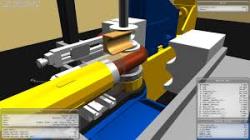
The first element of the new software release is an all-new version of the company’s three-dimensional simulator – Opt2Sim – to accelerate the development of control programs for all-electric tube bending machines. Previously a discrete add-on to Unison’s Unibend machine control software, the simulator has been completely re-engineered for total compatibility and accuracy of simulation. It now employs exactly the same embedded code that the machine runs on, ensuring that the simulator always performs in exactly the same manner as the machine – even as new machine control software features are added. The package will also now simulate the bending of additional tubular profiles such as square and rectangular – extending the versatility of application.
Unison’s latest Opt2Sim package enables fully validated bending programs to be created entirely off-line, and is suitable for any machine in the company’s Breeze range of all-electric tube benders. The new version also incorporates a completely re-engineered collision detection utility, substantially simplifying a time-consuming task faced by users. The utility can now be used to avoid and verify a wider range of problem scenarios including collisions between tube and machine, tube and tooling, tube and the surrounding environment, or the tube hitting itself. In this iteration of the software the user is even able to select the exact position he/she would like to view any collision – to make problems easy to understand and resolve.
A second major element of Unison’s software launch is a new version of the machine programming and control package, Unibend. Version 11.3 features significant speed enhancements to both the bending and material handling elements of tubular part programs. New bend cycle software further improves speed by some 5%. There is also a new TEACH facility giving users unprecedented access to the underlying machine code for handling parts – effectively allowing machine operation to be micro-managed for additional efficiencies. All a user needs to do is right-click on the relevant part of any program, and the underlying code is presented in an easy to understand and editable form, allowing rapid changes to be made.
The TEACH feature can be exploited in many ways – such as optimising speed of operation by controlling individual and multiple axis movements including the use of synchronised, parallel movements of multiple axes. Or, the facility could be used to slow movement – decreasing axis speed or inserting pauses or stops. In this way, users can fine-tune the standard bending and machine control sequences that the package generates to create highly optimised bending programs. The feature might be used to allow inspection at an interim stage for example, to slow movements to dampen vibration, to better handle lighter or heavier parts, to position the carriage to simplify unloading, or in many other ways. During use at one of Unison’s beta sites for the new software, these new Unibend features allowed a user to shorten the cycle time for a complex multi-bend tubular part by nearly 20%.
Another significant new feature of Unibend is much finer control over the profile motion of the important carriage feed and follower axes. Users can now choose to use up to 10 different movement speeds at as many as 10 different points on any bend – providing immense flexibility to optimise bending programs for difficult materials and bend shapes. This feature is expected to be of particular help for users bending tubes to very tight radii, such as 1D (one diameter of the tube). Such tight bending has become increasingly important in many sectors, like aerospace, where there is a growing need to save weight or space, while still maintaining a high integrity tubing structure.
The final new software feature is a database and data collection package that can be used in conjunction with the control system’s Ethernet compatibility to provide detailed information on machine usage. The package collects, stores and transmits comprehensive information on machine usage such as detailed information on machine actions including start and stop times of bend sequences, the part and batch being worked on. It also collects machine diagnostics information including any error notifications, alarms, emergency stops, etc. This information is made available over the Ethernet network for local and remote monitoring, and for connection to an enterprise’s material requirements planning (MRP) software. A local supervisor can monitor tube bending production in real-time for example, seeing what bending program is being used by any machine, the speed at which parts are being produced, etc. Higher level management could use the facility to generate reports showing information such as progress with batches and orders, reports showing total output, machine and operator productivity, etc.
According to Unison’s Alan Pickering, “All-electric tube bending machines have been around for a couple of decades and have opened up a new world of higher productivity for many different types of manufacturing enterprises. The flexibility of the associated software utilities for programming, operating and managing machines represents the next frontier for progress, and with these new introductions we believe we are laying the foundations for further step-change increases in tube bending productivity.”
Corporate Comm India (CCI Newswire)






























